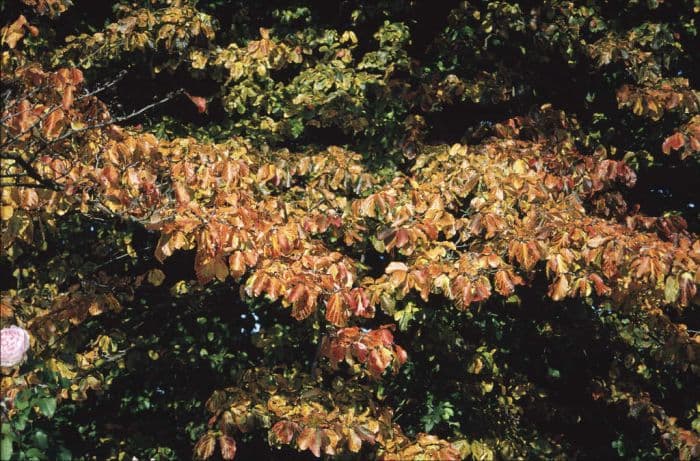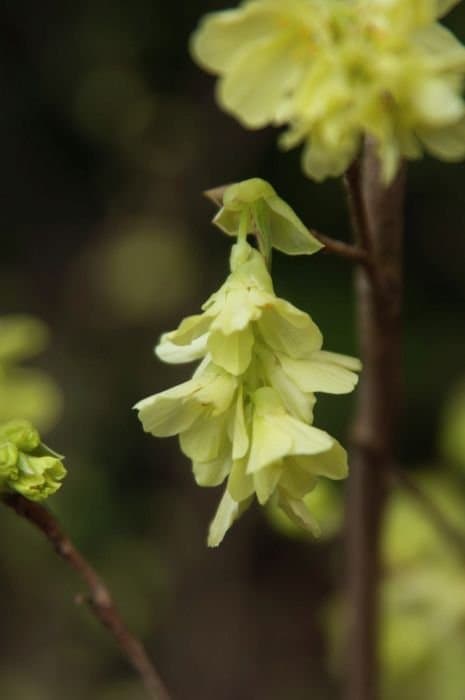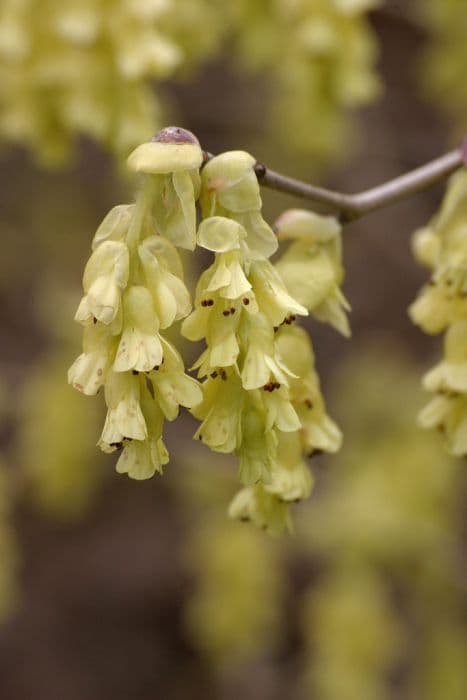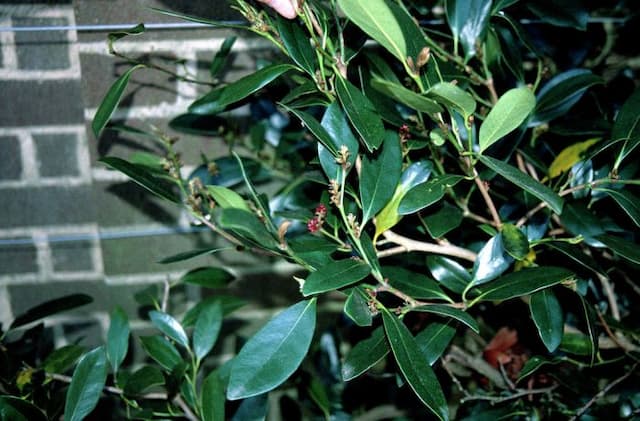Persian Ironwood Parrotia persica

ABOUT
Commonly known as Persian ironwood, this plant is an eye-catching addition to any landscape. It is characterized by a broad, rounded canopy and a habit that creates a picturesque, often multi-stemmed form. The bark of Persian ironwood is one of its most distinctive features, exfoliating to reveal a mosaic of greens, whites, and grays that provide year-round interest. The leaves emerge in the spring with a fresh green hue, some with subtle purple undertones, and as they mature, they develop into a lustrous, dark green. The foliage presents a stunning autumn display when temperatures drop, transitioning through a spectrum of bright yellow, orange, and deep red before falling. Spring also brings small, yet show-stopping, red flowers that lack petals but feature prominent, showy stamens that create a vibrant contrast against the emerging leaves. Following the flowers, the plant produces small brown fruits that may attract wildlife. The overall form and features of the Persian ironwood make it a striking specimen throughout the seasons, offering a dynamic blend of colors and textures to the landscape.
About this plant
 Names
NamesFamily
Hamamelidaceae
Synonyms
Persian Ironwood, Persian Parrotia, Ironwood
Common names
Apollonias persica, Hamamelidium persicum, Parrotia persica var. atropurpurea.
 Toxicity
ToxicityTo humans
Persian Ironwood is not known to be toxic to humans. There are no well-documented cases of poisoning from ingestion of any parts of this plant, and it is generally considered safe with respect to human contact and consumption.
To pets
Persian Ironwood is also not recognized as toxic to pets. It is not listed amongst plants that are known to cause poisoning in animals, so ingestion of this plant is unlikely to lead to symptoms of toxicity in pets. However, as with any non-food plant, excessive consumption can potentially cause gastrointestinal upset in some animals.
 Characteristics
CharacteristicsLife cycle
Perennials
Foliage type
Deciduous
Color of leaves
Varies
Flower color
Red
Height
20-40 feet (6-12 meters)
Spread
15-30 feet (4.5-9 meters)
Plant type
Tree
Hardiness zones
4-8
Native area
Iran
Benefits
 General Benefits
General Benefits- Ornamental value: Parrotia persica, commonly known as Persian ironwood, is prized for its attractive foliage, which changes color with the seasons, providing year-round visual interest.
- Low maintenance: Once established, Persian ironwood is drought tolerant and requires minimal care, making it an ideal choice for low-maintenance landscapes.
- Longevity: Persian ironwood is known for its long lifespan, which can be an attractive feature for landscaping projects with a long-term perspective.
- Wildlife attraction: The tree provides habitat and food for various birds and insects due to its dense canopy and production of small flowers and fruit.
- Shade provision: With its wide canopy, Persian ironwood can offer a significant amount of shade, making it a valuable addition to parks and gardens for cooling and shelter.
- Erosion control: The root system of Persian ironwood helps to stabilize the soil, which can be beneficial in preventing erosion on slopes and in riparian zones.
- Urban tolerance: Persian ironwood is notably tolerant of urban conditions such as pollution and constrained soil spaces, which makes it suitable for city planting.
- Seasonal interest: The tree provides a burst of color in the landscape with its autumn foliage colors ranging from yellow to deep red, creating visual appeal in the cooler months.
- Structural presence: The unique patterned exfoliating bark of Persian ironwood presents an interesting structural look, adding to the textural diversity in a landscape design.
- Cultural significance: Persian ironwood is native to regions of northern Iran and has cultural significance, which can be an aspect of interest in thematic gardens or educational environments.
 Medical Properties
Medical PropertiesThis plant is not used for medical purposes.
 Air-purifying Qualities
Air-purifying QualitiesThis plant is not specifically known for air purifying qualities.
 Other Uses
Other Uses- Woodworking: The wood of Parrotia persica, commonly known as Persian Ironwood, is highly valued for its durability and is often used in fine woodworking, including furniture making and cabinetry.
- Dye Production: The leaves and bark of Persian Ironwood can be used to produce tannins for dyeing fabrics a luscious brown tone, which is useful in the textile industry.
- Landscape Structure: Owing to its resistance to wind and strong structure, Persian Ironwood is planted as a windbreak or as an architectural feature in landscape design.
- Urban Forestry: Persian Ironwood is planted in urban areas as a street tree since it is tolerant to pollution and provides shade and aesthetic beauty to city streets.
- Garden Sculpture: Dead or pruned branches of Persian Ironwood may be used as natural sculptures or artistic garden elements due to their unique form and resilience to decay.
- Horticultural Grafting: Persian Ironwood can be used as a rootstock for grafting other plant species, benefiting from its hardy root system and growth habit.
- Photography and Painting Subjects: The vibrant fall colors and distinctive exfoliating bark of Persian Ironwood make it a popular subject for photographers and painters who capture its beauty.
- Wildlife Support: The tree can provide food in the form of its seeds for birds and small mammals, and its branches may serve as nesting sites.
- Educational Tool: Persian Ironwood's various adaptations and characteristics, such as its bark and leaf structure, are utilized for educational purposes in botany and dendrology courses.
- Habitat Restoration: Persian Ironwood trees are sometimes planted as part of ecological restoration projects to help reestablish native vegetation and improve biodiversity in degraded areas.
Interesting Facts
 Feng Shui
Feng ShuiPersian Ironwood is not used in Feng Shui practice.
 Zodiac Sign Compitability
Zodiac Sign CompitabilityPersian Ironwood is not used in astrology practice.
 Plant Symbolism
Plant Symbolism- Endurance and Resilience: Parrotia persica, commonly known as Persian Ironwood, is known for its hardy nature and ability to withstand tough conditions, symbolizing the wearer's resilience and endurance through challenging times.
- Change and Transformation: The Persian Ironwood undergoes a striking change of colors in its foliage throughout the seasons, which can symbolize the nature of change and the process of transformation in a person's life.
- Beauty and Grace: With its attractive flowers and eye-catching fall colors, Persian Ironwood represents beauty and grace, marking the presence of these qualities in events or individuals associated with it.
- Longevity: Due to its long lifespan, this plant can symbolize longevity and continuance, wishing a long and healthy life for someone or commemorating an enduring relationship or institution.
 Water
WaterThe Persian Ironwood should be watered when the top inch of soil has dried out, which typically means watering once a week during the growing season and reducing frequency in the winter months. Use enough water to moisten the soil throughout the root zone, which can be approximately 1 to 2 gallons for a medium-sized tree in an average week, but this will vary depending on the size of the plant and the environmental conditions. Over-watering can be detrimental, so it's important to ensure good drainage and never let the tree sit in water.
 Light
LightPersian Ironwood thrives in full sun to partial shade. The best spot for this plant would be a location where it can receive at least four hours of direct sunlight daily. However, it can also do well in dappled sunlight, which might be preferable in areas with very hot summers.
 Temperature
TemperatureThe ideal temperature range for a Persian Ironwood is between 60°F and 80°F. It can withstand temperatures as low as 30°F and as high as 90°F, but it does best when temperatures are moderate. It is important to protect the tree from extreme cold or sudden temperature drops, which can be damaging.
 Pruning
PruningPruning Persian Ironwood is mainly done to remove dead or diseased wood and to maintain its natural shape. The best time for pruning is late winter or early spring, before new growth begins. Pruning should be undertaken cautiously and not too frequently as the tree has a naturally attractive form and excessive cutting can lead to poor growth and structure.
 Cleaning
CleaningAs needed
 Soil
SoilPersian Ironwood prefers well-drained, fertile soil with a slightly acidic to neutral pH, ideally between 6.0-7.0. A mix of loam, peat, and sand in equal parts can create a suitable growing medium for this plant, promoting good root health and moisture retention while allowing excess water to drain away properly.
 Repotting
RepottingPersian Ironwood trees are slow-growing and rarely need repotting. They are typically planted directly in the landscape where they can grow undisturbed. If grown in a container, young trees might be repotted every 2-3 years to accommodate root growth, while mature trees can remain in the same pot for longer, provided the soil is replenished.
 Humidity & Misting
Humidity & MistingPersian Ironwood is tolerant of a wide range of humidity levels but thrives best in moderate to high humidity. It does not require any special humidity requirements when planted outdoors in its appropriate hardiness zones, as it can adapt to the natural environment.
 Suitable locations
Suitable locationsIndoor
Provide bright light and space; infrequent watering is key.
Outdoor
Plant in well-drained soil, full sun to part shade; mulch well.
Hardiness zone
4-8 USDA
 Life cycle
Life cycleParrotia persica, commonly known as Persian Ironwood, begins its life cycle as a seed, which germinates in the spring to produce a small seedling. The seedling grows through the vegetative stage, developing a strong root system and woody stem, and in approximately 5 to 10 years, it matures into an adult tree capable of flowering. Flowers appear in late winter to early spring before the leaves, with small, red, petal-less blooms that are quite inconspicuous. After pollination, typically by wind or insects, the flowers develop into small, brown, nut-like fruits which, when mature, release seeds to start a new generation. The Persian Ironwood reaches peak maturity over several decades and is known for its remarkable longevity, often living for more than a century. Throughout its life, the plant experiences annual cycles of leaf growth in the spring, followed by a vibrant fall color change and leaf drop in the autumn.
 Propogation
PropogationPropogation time
Late winter-early spring
The most popular method of propagation for the Parrotia persica, also known as Persian Ironwood, is via seed. The best time to sow seeds is in autumn, directly after they are collected, as they require a period of cold stratification to break dormancy. This can be naturally achieved by the winter conditions if sown outdoors. Alternatively, stratification can be manually done by mixing the seeds with slightly moist sand and placing them in a plastic bag, which is then stored in a refrigerator at about 34 to 41 degrees Fahrenheit (1 to 5 degrees Celsius) for approximately two to three months. After the cold treatment, seeds can be sown in a well-draining seed starting mix, lightly covered with soil, and kept moist until germination occurs, which may take several weeks. Once seedlings emerge and grow strong enough, they can be transplanted into individual pots or their final location outdoors.









